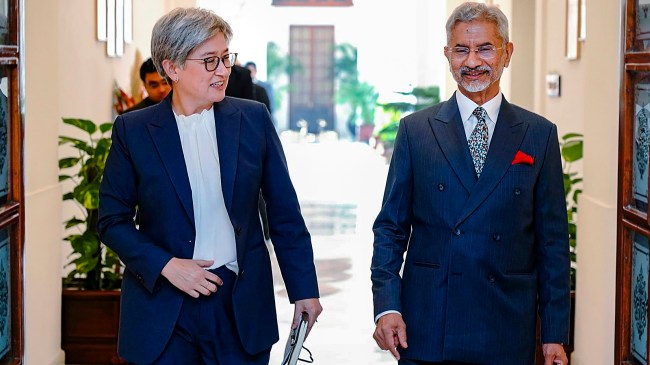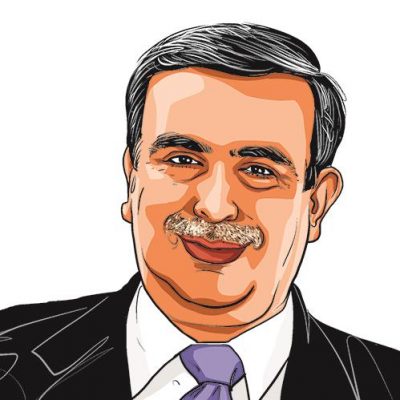Opinion Between India and Australia, lots of love and some caution
The bonhomie on display at the recent 2+2 ministerial dialogue is a refreshing change from the past. But like all tempestuous relationships that can be subject to mood swings, this bilateral relationship can easily go south unless it is protected and nurtured
 External Affairs Minister S Jaishankar with Australian Foreign Minister Penny Wong after the 14th India-Australia Foreign Ministers Framework Dialogue, in New Delhi on Tuesday. (Photo: PTI)
External Affairs Minister S Jaishankar with Australian Foreign Minister Penny Wong after the 14th India-Australia Foreign Ministers Framework Dialogue, in New Delhi on Tuesday. (Photo: PTI) Last week’s images of the smiling and relaxed Australian Foreign Minister, Penny Wong, and the almost cavalier confidence with which she played “street” cricket on the lawns of the Australian High Commission, in New Delhi (on the sidelines of the 2+2 Ministerial Dialogue), was a moment of epiphany for followers of the bilateral relationship. It revealed the extent of the dramatic transformation in India’s ties with Australia that has far exceeded the expectations of even the most optimistic supporter. “This is”, as a long-time observer pointed out, “as cool as it can get!” Today, India is almost in the category of Australia’s best mates, and New Delhi’s South Block insiders suggest that they have bahut bharosa in Canberra.
But like all tempestuous relationships that can be subject to mood swings, this bilateral relationship can easily go south unless it is protected and nurtured. In the language of Australian family law, it is still a de facto partnership that either side could exit without incurring the costs of a long-standing marriage.
Be that as it may, when I founded the Australia India Institute over a decade ago, we had hoped for, at best, a “normal” relationship that would not be scarred by violence against Indian students on the streets of Melbourne, or magazine covers that screamed “Why do the Aussies hate us?” Instead, we have today a relationship on steroids; full of verve, energy and enthusiasm — across the spectrum of issues that once divided us, and this was also evident in the Australia India Leadership Dialogue recently convened in Melbourne.
Last week, again, as we softly launched our book, Strategic Choices, Ethical Dilemmas: Stories from the Mahabharat (co-authored with Aruna Narlikar and Amrita Narlikar) at University House, close to the vaults that hold the archives of one of Melbourne University’s most celebrated alumna, the radical feminist Germaine Greer, there was serious discussion about the need to mainstream Indian texts within the University’s syllabus.
This, at a University that had once closed its India studies programme and dumped its collection of books at La Trobe University, and whose insular depths forced the young and the bright like Greer to move abroad. But in 2023, with Melbourne University ranking amongst the top 40 in the world, its academic cosmopolitanism ranges from a commitment to indigenous studies to embracing the region it geographically belongs to, rather than the Anglo-Celtic world that it had inherited.
Consider, first, the montage of bilateral colour of just these last couple of weeks. The World Cup cricket final in Ahmedabad tested the limits of our “friendly” rivalry and love for the sport, as Australia trounced India in what turned out to be an unusually one-sided game. But at the end of the day, a mutual passion for the game drowned the trolls who seemed to be inhabiting a make-believe world of hyper-nationalism.
As Vini Raman Maxwell, the India-born wife of the Australian cricketer, Glen Maxwell, subject to trolling, put it so well: “Can’t believe this needs to be said but you can be Indian and support the country of your birth where you have been raised and, more importantly, the team your husband and father of your child plays in… Take a chill pill and direct that outrage towards more important world issues.”
But the real sense of substantial progress was provided by the 2 +2 Ministerial Dialogue between the ministers of defence and foreign affairs from the two countries, in New Delhi on November 20. The momentum provided by the India-Australia Comprehensive Strategic Partnership (CSP), and the first India-Australia Annual Summit between Prime Minister Narendra Modi and Prime Minister Anthony Albanese earlier this year was reflected in the 47-para joint statement that covered a range of issues from defence, and diplomacy to development.
For all those who believe in the vast potential of collaboration on skills and higher education, the signing of the Mechanism for Mutual Recognition of Qualifications between the two countries has been a great leap forward. At the 2+2 dialogue, the ministers “agreed to further deepen cooperation in the field of internationalisation of education and fostering institutional-level linkages between the two countries under various modes like twinning, joint degrees, and dual degrees.” What is most exciting is the move by Australian universities in setting up offshore campuses in India and focusing on the six prioritised areas of health and care sectors, agriculture, renewable energy, digital, mining and logistics, and strengthening educational partnerships and advancing research through internationalisation. The Australia India Leadership Dialogue further reaffirmed this in Melbourne.
But even given this bonhomie, there are red flags that are worth raising. If in the cliched past, only curry, the commonwealth and cricket united us, today China, critical minerals and “Canada” could pose as possible problems that could hurt ties.
At the sidelines of the 2+2, Defence Minister Richard Marles described China as a source of both national wealth and anxiety for both India and Australia — a relationship described by former Prime Minister Tony Abbott as one rooted in fear and greed. But with the growing impression that the Albanese government is going out of its way to engage the present Chinese regime and critics accusing it of even “appeasing” the Xi Jinping-led leadership, this is an issue on which New Delhi and Canberra need a candid conversation.
Similarly, Australia and India are committed to decarbonisation of energy systems that would require substantial Australian exports of critical minerals including lithium, nickel, cobalt, copper and rare earth elements (REEs) for renewable energy installations and storage solutions. But not much progress seems to have been made in translating the promise into reality, in the foreseeable future.
Finally, there needs to be much greater conversation between India’s intelligence agencies collectively with the Five Eyes (FVEY) and individually with intelligence agencies in Australia so that issues of Khalistani and other forms of separatism do not have the potential to undermine the relationship in the future.
The writer is Professor at JNU, founder of the Australia India Institute, University of Melbourne and co-author of the forthcoming Strategic Choices, Ethical Choices: Stories from the Mahabharat





